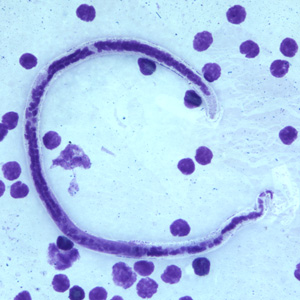Brugia malayi - Laboratory diagnosis
Laboratory diagnosis of Brugia malayi
The laboratory diagnosis of Brugia malayi is done by demonstration of the parasite in the samples, immunodiagnostic methods, or molecular procedures.
Samples
peripheral blood
hydrocele fluid
lymph node aspiration
Blood Microscopy
Blood microscopy is done for diagnosis of Brugia malayi infection. The peripheral blood is collected during the time when a large number of microfilariae are found in the peripheral blood. For nocturnal periodic Brugia malayi, blood is collected between 10 pm and 4 am.
By finger prick method, 2 to 3 drops of peripheral blood are collected and viewed under a microscope.
Blood microscopy is done by:
Direct Wet Mount
Stained thick blood film smear
Concentration of blood
Direct Wet Mount
Direct wet mount microscopy of blood for laboratory diagnosis of Brugia malayi involves the collection of 2 to 3 drops of peripheral blood on a clean glass slide and examination under a microscope.
The presence of live microfilariae, characterized by serpentine movement in the blood plasma, confirms the diagnosis.
Stained thick blood film smear
As the name suggests, stained thick blood film smear involves thick blood smear stained with Giemsa or Leishman stain. The presence of a sheath with a row of nuclei and two separate nuclei in the tail of microfilaria confirms infection of the patient by Brugia malayi.
Concentration of blood
If the number of microfilariae in the blood is less, various methods are followed for the concentration of blood. Such methods include:
Knott’s method of concentration by sedimentations
membrane filtration by Millipore membrane filter or nucleophore membrane filter
* membrane filter methods are sensitive methods

Brugia malayi in a blood smear (Source: CDC)
DEC provocation test
DEC provocation test involves oral administration of DEC (diethylcarbamazine) to stimulate nocturnal periodic Brugia malayi microfilariae to circulate in the peripheral blood during daytime. This is done when a collection of blood samples during the night is difficult.
Procedure:
administer DEC at a dose of 2-8 mg/kg body weight
collect capillary blood by finger prick method after 30 minutes
observe blood samples for the presence of microfilaria
direct wet mount microscopy or staining blood smear is done
QBC
QBC method is done to demonstrate circulating microfilariae in the blood for the laboratory diagnosis of Brugia malayi infection.
Hydrocele fluid, lymph node aspiration microscopy
Samples such as hydrocele fluid, and lymph node aspiration are visualized under a microscope to test for microfilariae of Brugia malayi.
Immunodiagnosis
Immunodiagnosis is important in the diagnosis of filariasis – mostly the amicrofilaeiaemic states. It consists of:
Serological methods
Cellular assays
Serological methods
The serological methods include tests for the demonstration of circulating antibodies or for the demonstration of circulating antigens.
Demonstration of circulating antibodies
This involves antibody-based immunoassays. The disadvantage of these immunoassays is that they show cross-reactions with other filarial, and helminthic infections and are unable to differentiate past and active infections due to the presence of antibodies even after cure.
Antibody-based immunoassays used for laboratory diagnosis of Brugia malayi are:
Indirect haemagglutination assay (IHA)
Indirect fluorescent antibody (IFA)
Enzyme-linked immunosorbent assay (ELISA)
Radio-immunoassay (RIA)
Luminescence immunoassay
Demonstration of circulating antigens
Demonstration of circulating Brugia malayi antigens has an advantage as circulating filarial antigens are only present during recent or current infection and disappear from circulation following clinical cure. Thus, it is useful for the differentiation of past and recent infections.
In addition, blood can be collected anytime for these methods of diagnosis.
Antigen-based immunoassays used for laboratory diagnosis of Brugia malayi are:
Enzyme-linked immunosorbent assay (ELISA) based on monoclonal antibody
ICT filariasis card
Cellular assays
These assays are not specific, which is a major disadvantage.
Methods of cellular assays include:
filarial skin test
in-vitro lymphocyte response to filarial antigens
Molecular methods
PCR
Other methods
Ultrasound
It is a non-invasive method for the detection of live Brugia malayi – identified by distinct movement patterns called ‘filarial dance signs.’
Biopsy
Biopsy of enlarged lymph nodes, in close proximity to affect lymph vessels, is done to demonstrate adult Brugia malayi parasites.